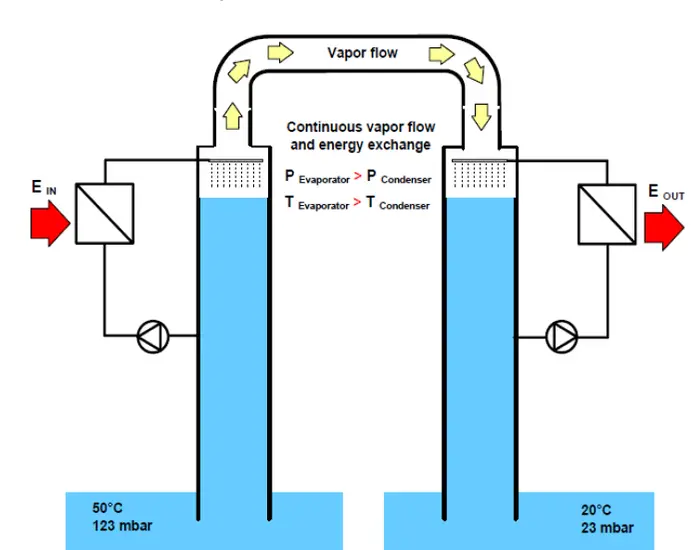What’s behind the refreshing chill of your AC on a sweltering day? It’s the vapor cooling effect! This incredible phenomenon has changed how we keep cool, from our homes to factories. Ready to dive into the cool world of vapor cooling?

We’ll explore the nitty-gritty of this powerful effect and how it’s transforming temperature control. Get ready for a rollercoaster ride through the awesome benefits of vapor cooling, and find out how this game-changer can boost your cooling system’s performance while being eco-friendly. Let the adventure begin, and uncover the secrets of the vapor cooling effect!
Table of Contents
Introduction to Vapor Cooling Effect
Definition of Vapor Cooling
So, what is vapor cooling? It’s a natural phenomenon that uses the evaporation process to remove heat from the air, making your home more comfortable. Think of it like a cold glass of lemonade on a hot summer day. When water evaporates, it takes heat with it, creating a cooling effect. Cool, right?
Importance of the Vapor Cooling Effect
Why should you care about vapor cooling? For starters, it’s used in various industries, such as air conditioning and refrigeration. More importantly, it’s an energy-efficient and eco-friendly way to cool your home. In other words, it’s great for both your wallet and Mother Earth.
Physics Behind Vapor Cooling
Evaporation Process
Let’s dive into the science a bit. The key to vapor cooling lies in the evaporation process. When a liquid turns into vapor, it absorbs heat from its surroundings (called latent heat of vaporization). This process is affected by factors like temperature, humidity, and air movement.
Heat Transfer Mechanisms
Heat travels in three ways: conduction, convection, and radiation. Vapor cooling relies on convection, as the cool air produced by evaporation circulates throughout your home. It’s like a gentle, invisible breeze bringing relief from the heat.
Psychrometrics
Ever heard of psychrometrics? It’s the study of air and its properties. By understanding the relationship between temperature, humidity, and air pressure, we can optimize vapor cooling systems for maximum comfort and efficiency.
Vapor Cooling Systems
Direct Evaporative Cooling
There are different types of vapor cooling systems. Direct evaporative cooling involves passing air through a wet medium, like a damp pad. As the air evaporates the water, it cools down. This method is simple and cost-effective, but it can increase humidity, which might not be ideal in some climates.
Indirect Evaporative Cooling
Indirect evaporative cooling, on the other hand, uses a heat exchanger to cool the air without adding moisture. It’s more complex and expensive than direct cooling, but it’s a better fit for humid areas.
Hybrid Evaporative Cooling Systems
Can’t decide between direct and indirect? Why not have both! Hybrid systems combine the best of both worlds, offering increased efficiency and flexibility for various climates and applications.
Learn more on vapor refrigeration: Vapor Refrigeration: Easy Guide to Keeping Things Chill
Practical Applications of Vapor Cooling
Residential and Commercial Buildings
Vapor cooling systems can be tailored to suit different climates and building types. With the right design considerations and best practices, you can enjoy a comfortable and energy-efficient home or office, no matter where you live.
Industrial Processes
It’s not just homes and offices that benefit from the vapor cooling effect. Manufacturing and production facilities can also use this technology to reduce energy consumption and costs. Imagine the savings for your business!
Data Centers
Keeping data centers cool is a massive challenge. Enter vapor cooling technologies! These systems help maintain optimal temperatures for servers and other equipment, ensuring smooth operation and reducing energy costs. Talk about a win-win!
Environmental and Economic Impacts
Energy Efficiency
When it comes to energy efficiency, vapor cooling systems take the cake. Compared to conventional cooling methods, they can significantly reduce energy consumption, leading to lower utility bills and a smaller carbon footprint. Who doesn’t love saving money and the planet?
Water Usage
While vapor cooling systems do use water, there are strategies to minimize consumption. By recycling water or using alternative water sources, these systems can be more eco-friendly and cost-effective. Every drop counts!
Climate Change and Sustainability
By reducing greenhouse gas emissions and conserving resources, vapor cooling plays a vital role in achieving sustainability goals. So, not only do you enjoy a comfortable home, but you’re also contributing to a healthier planet. Good on you!
Future Trends and Developments
Emerging Technologies
The world of vapor cooling is always evolving. New materials and design innovations promise even greater efficiency and effectiveness. Stay tuned for the latest breakthroughs that could revolutionize the way we keep cool.
Integration with Renewable Energy
Imagine pairing vapor cooling systems with renewable energy sources like solar power. The result? Net-zero energy buildings that produce as much energy as they consume. The future of sustainable living is within reach!
Policy and Regulatory Considerations
As the popularity of vapor cooling grows, so do incentives for adopting these technologies. Keep an eye out for government programs and industry standards that promote the implementation of energy-efficient cooling systems. You might be eligible for some sweet deals!